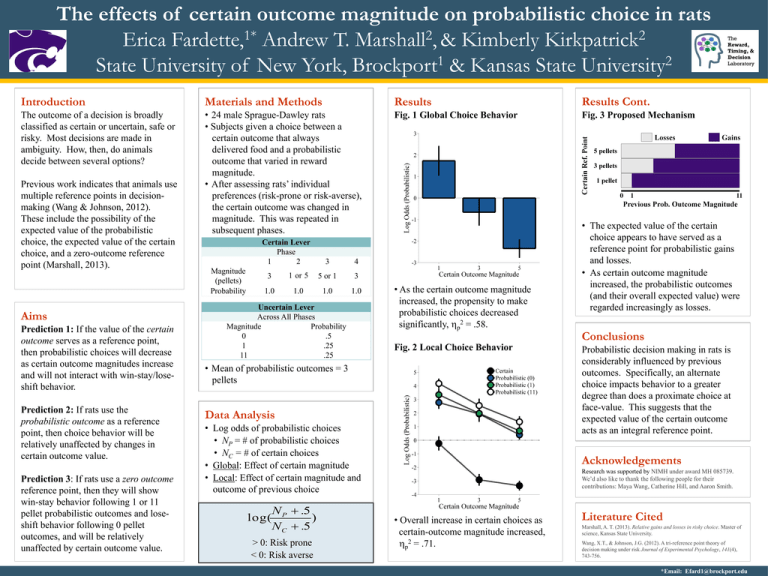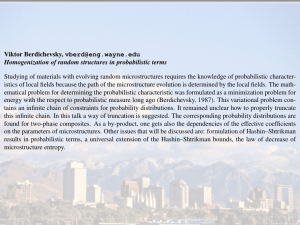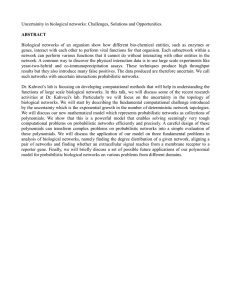The effects of certain outcome magnitude on probabilistic choice... Erica Fardette, Andrew T. Marshall , & Kimberly Kirkpatrick
advertisement

The effects of certain outcome magnitude on probabilistic choice in rats 1* 2 2 Erica Fardette, Andrew T. Marshall , & Kimberly Kirkpatrick 1 2 State University of New York, Brockport & Kansas State University Introduction Materials and Methods Results Results Cont. The outcome of a decision is broadly classified as certain or uncertain, safe or risky. Most decisions are made in ambiguity. How, then, do animals decide between several options? • 24 male Sprague-Dawley rats • Subjects given a choice between a certain outcome that always delivered food and a probabilistic outcome that varied in reward magnitude. • After assessing rats’ individual preferences (risk-prone or risk-averse), the certain outcome was changed in magnitude. This was repeated in subsequent phases. Fig. 1 Global Choice Behavior Fig. 3 Proposed Mechanism Previous work indicates that animals use multiple reference points in decisionmaking (Wang & Johnson, 2012). These include the possibility of the expected value of the probabilistic choice, the expected value of the certain choice, and a zero-outcome reference point (Marshall, 2013). Aims Prediction 1: If the value of the certain outcome serves as a reference point, then probabilistic choices will decrease as certain outcome magnitudes increase and will not interact with win-stay/loseshift behavior. Prediction 2: If rats use the probabilistic outcome as a reference point, then choice behavior will be relatively unaffected by changes in certain outcome value. Prediction 3: If rats use a zero outcome reference point, then they will show win-stay behavior following 1 or 11 pellet probabilistic outcomes and loseshift behavior following 0 pellet outcomes, and will be relatively unaffected by certain outcome value. Certain Lever Phase 1 2 Magnitude (pellets) Probability 3 4 3 1 or 5 5 or 1 3 1.0 1.0 1.0 1.0 Uncertain Lever Across All Phases Magnitude Probability 0 .5 1 .25 11 .25 • As the certain outcome magnitude increased, the propensity to make probabilistic choices decreased 2 significantly, hp = .58. Fig. 2 Local Choice Behavior • Mean of probabilistic outcomes = 3 pellets Data Analysis • Log odds of probabilistic choices • NP = # of probabilistic choices • NC = # of certain choices • Global: Effect of certain magnitude • Local: Effect of certain magnitude and outcome of previous choice N P .5 log( ) N C .5 > 0: Risk prone < 0: Risk averse • The expected value of the certain choice appears to have served as a reference point for probabilistic gains and losses. • As certain outcome magnitude increased, the probabilistic outcomes (and their overall expected value) were regarded increasingly as losses. Conclusions Probabilistic decision making in rats is considerably influenced by previous outcomes. Specifically, an alternate choice impacts behavior to a greater degree than does a proximate choice at face-value. This suggests that the expected value of the certain outcome acts as an integral reference point. Acknowledgements Research was supported by NIMH under award MH 085739. We’d also like to thank the following people for their contributions: Maya Wang, Catherine Hill, and Aaron Smith. • Overall increase in certain choices as certain-outcome magnitude increased, hp2 = .71. Literature Cited Marshall, A. T. (2013). Relative gains and losses in risky choice. Master of science, Kansas State University. Wang, X.T., & Johnson, J.G. (2012). A tri-reference point theory of decision making under risk Journal of Experimental Psychology, 141(4), 743-756. *Email: Efard1@brockport.edu





